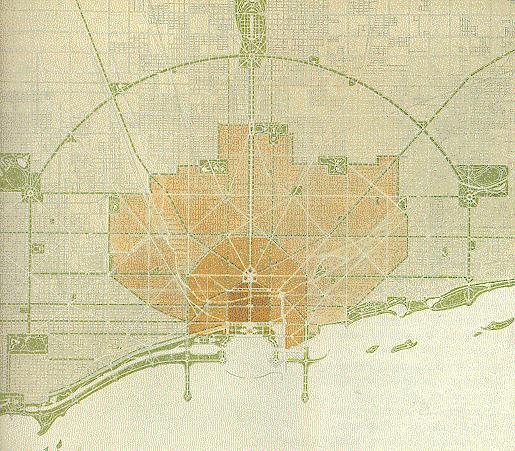Urban Planning in North America came into its own during the twentieth century. Cities began to reach critical mass and the need for regulations and coded emerged. Given the robust amount of activity that occurred during this time, I’m going to slow things down a bit and look at each decade a bit more in-depth. Today will look at 1900-1909:
1901 McMillan Plan (Washington D.C.)
The McMillan Plan was an architectural plan for Washington, D.C., formulated in 1902 by the Senate Park Improvement Commission of the District of Columbia. The commission was named for its chairman, Senator James McMillan of Michigan.

Some of the greatest American architects, landscape architects, and urban planners of the day served on the McMillan Commission, including Daniel Burnham, Frederick Law Olmsted, Jr., Charles F. McKim, and Augustus Saint-Gardens. They were inspired by the original 1791 plan for the city by architect Pierre (Peter) Charles L’Enfant, which had never been fully realized. The commission also sought to emulate the grandeur of European capitals such as Paris, London, and Rome.
The McMillan Plan in many respects was an early form of urban renewal. Commissioners were strongly influenced by the City Beautiful movement, a progressive ideology that intended to build civic virtue in the poor through monumental architecture. The plan removed many of the slums that surrounded the Capitol, replacing them with new public spaces, monuments and government buildings, including the National Mall and the Burn ham designed Union Station.
1904 Great Fire of Toronto

The Great Fire of Toronto of 1904 was the second great fire that destroyed a large section of the city’d Downtown on April 19th. It is the largest fire ever in the city, although a previous large fire had consumed many city blocks on April 7, 1849 when the city was much smaller and constructed mostly with wood.
The fire began on the evening of the 19th and took nine hours to get under control. The battle was made more difficult by strong winds and sub-zero temperatures. The fire destroyed 104 buildings, but killed no one. It caused over $10 million (1904 dollars) in damage and put five thousand people out of work (of a total population of only 200,000). As a result of the fire, City Council worked fast to pass a new building by-law, setting standards for fire-resistant (for the time) construction and expand the city’s fire department.
1909 Welch v. Swasey
 A leading pre-zoning decision by the United States Supreme Court that established the right of municipalities to regulate building height.
A leading pre-zoning decision by the United States Supreme Court that established the right of municipalities to regulate building height.
Francis C. Welch owned property in a residential section of Boston where building height was legislatively limited to 100 feet (30.5 m). After he was denied a permit to build a 124-foot (37.8 m) building on his property, Welch sued, contending:
that the purposes of the acts are not such as justify the exercise of what is termed the police power, because, in fact, their real purpose was of an aesthetic nature, designed purely to preserve architectural symmetry and regular skylines.
The Courts opinion, delivered by Justice Rufus Wheeler Peckham, acknowledged Welch’s claim that “there is here a discrimination or classification between sections of the city,” but nonetheless adopted a standard of review deferential to local government expressing that the Court :
feels the greatest reluctance in interfering with the well-considered judgments of the courts of a state whose people are to be affected by the operation of the law.
1909 First National Conference on City Planning
On May 21 and 22, 1909, the “First National Conference on City Planning and the Problems of Congestion” was held in Washington, D.C., with 43 attendees. It was organized by Benjamin Clarke Marsh, a leading social reformer from New York and Henry Morgenthau, a lawyer and real estate developer. Both were involved with New York City’s Committee on Congestion.
The conference brought together the leaders of the housing and city planning movements. As a result of the first conference and the obvious interest in planning, the group organized itself as the National Conference on City Planning. The first chairman of the NCCP executive committee, elected at the Washington meeting, was Frederick L. Ford, city engineer of Hartford, Connecticut.
1909 Burnham Plan
The 1909 Plan of Chicago of 1909 was co-authored by Daniel H. Burnham and Edward H. Bennett. Popularly known as the Burnham Plan, it featured waterfront parks and prominent civic buildings, applying the principles of the City Beautiful Movement. Burnham, an architect who had managed the construction of the 1893 World’s Columbian Exposition in Chicago, retained Edward Bennett as co-author, and a small staff to help prepare the plan.
It was the first comprehensive plan for the growth of a large American city and is sometimes referred to as America’s first regional plan. An outgrowth of the City Beautiful movement, the plan included ambitious proposals for the lakefront and river and declared that every citizen should be within walking distance of a park. Through controversial, the plan’s focus on big infrastructure improvements served a rapidly growing city at a time when an expanding tax base made it possible to undertake large project
While only partially realized, the Burnham Plan reshaped Chicago’s central area and was an important influence on the emerging field of city planning, anticipating future need to control unexpected urban growth, and continued to influence the development of Chicago to this day.
Other Posts in this Series


2 thoughts on “A Brief History of Urbanism in North America: 1900-1909”
Comments are closed.